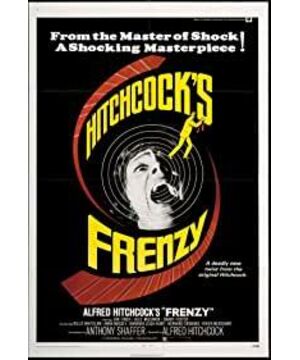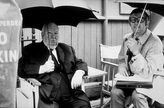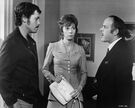When the staff of the marriage agency passed by the male lead Richard, the camera did not follow the staff to film what happened upstairs, but stayed on the street for a long time. We all know that Richard's ex-wife has been killed upstairs. We all want to know how the staff will react when seeing the tragedy at the scene. There will definitely be loud screams, expressions of bewilderment and fear. But Hitchcock did not let the audience see this at all. All the spectators no longer have the window to watch wherever they want, but are arranged to wait downstairs. There are noisy sounds on the street. Every spectator stands there calmly, waiting for the sharp sound. Called.
Truffaut once described Hitchcock’s suspense this way: it is an extension of time, an extension of waiting, and a foil to all the elements that make our heart beat faster.
This scene is not a typical Hitchcock suspense scene, but it is full of suspense. Here, Hitchcock is like a naughty child playing with the audience. Don't you want to watch it? I don't want you to watch it. It is this kind of waiting that keeps time stretched out. While the audience was "waiting" downstairs, time was stretched and suspense was aggravated. The audience is no longer a spectator, but a participant in the story.
This technique is used in two other places in this film. The murderer took Barbara back to the room, where he followed them upstairs with a long lens. As the door closed, the perspective of the movie did not enter the room, but came down from the upper floor and onto the street. The audience knew that Barbara would be killed, but Hitchcock did not let the audience participate in the murder scene.
Another is that when Richard was on trial, the perspective of the movie became the guard at the scene. As the guard closed the door, the sound at the court hearing immediately became quieter, and the audience anxious to know the result must be thinking at this time: "Quickly Click to open the door!” Here, something like Roman Polans’s "Rosemary’s Baby" deliberately prevents the audience from seeing the events in the room, except that Polanski uses pictures, while Hitchcock controls It's the sound.
In the early years, Hitchcock films always had such a shooting method, first shooting the picture of the characters in the movie, and then cutting to the picture seen from the perspective of the characters in the movie. In this film, this way of film assembly obviously does not exist. Hitchcock manipulates the audience through the above techniques, making you invisible, making you inaudible, making you want to see, and making you want to hear. What remains the same is that Hitchcock is still the master of music conductor, manipulating the emotional changes of the audience.
View more about Frenzy reviews











